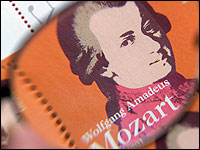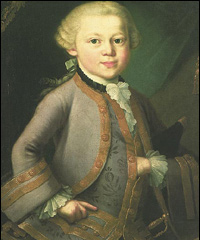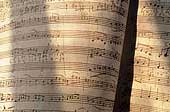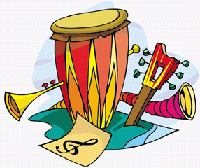| (insert your NIE or newspaper logo here) |
Weekly Online LessonOnline Lesson ArchiveGrade Level: 6-9
|
Mozart's Magic
 Music
lovers worldwide will be celebrating the 250th birthday of classical
composer Wolfgang Amadeus Mozart on January 27, 2006.
Music
lovers worldwide will be celebrating the 250th birthday of classical
composer Wolfgang Amadeus Mozart on January 27, 2006.
Mozart became a music composer at the age of five. Many experts believe that his upbringing among parents who were professional musicians themselves certainly nurtured his talents from birth. And even though he died at age 35, his legacy is one of the most recognized in the world today.
Mozart's impact goes beyond mere popularity, however. Scientists have found evidence that people who listen to his music—compared to that of other composers—may actually become smarter. Some medical professionals even use Mozart's music as therapy for Alzheimer's patients and others afflicted with brain dysfunction.
Of course, Mozart isn't the only musician to affect our cultures. Music is a significant part of people's lives everywhere in the world. This has become clear in other scientific studies, which have shown that a baby who has heard certain songs while in the mother's womb will recognize them even a year after being born.
To celebrate Mozart's birthday this week, you'll become familiar with the young composer through his life's story and his music. Then, you'll get to make some music of your own by using musical instruments that exist both online and all around you.
The Life of Mozart
 Begin
your lesson by exploring the life of this musician and composer, Wolfgang
Amadé Mozart.
Begin
your lesson by exploring the life of this musician and composer, Wolfgang
Amadé Mozart.
Click on Biography, and then select the episode: A miracle, born in Salzburg.
Read about Mozart's life as a child prodigy living and learning among his musical family.
For what reasons do historians believe his father was so involved in his son's talents and popularity? Where did Wolfgang, and his sister's, first performance abroad take place? What abilities did young Wolfgang have that set him apart from other musicians?
Next, open the second biography episode, The little German boy, where, you'll pick up the story in London.
What made visiting this city different from the others the family had toured? In what ways did Leopold Mozart help push his son into the public spotlight? What "blessing" occurred when Leopold became ill?
From the site's Main Menu, sit in on some of Mozart's Concerts. After choosing a type of composition, the song name will appear on a new screen. Click OK to open the curtains and hear the performance.
Here in the concert hall, listen to samples of Mozart's Sacral music, Opera and voice pieces, Orchestral Works, Chamber music, and Piano and organ.
 Listen
carefully as each sample plays. Try to pick out each instrument you
hear, and then write down each instrument's name or group (e.g.,
string, brass, percussion, etc.).
Listen
carefully as each sample plays. Try to pick out each instrument you
hear, and then write down each instrument's name or group (e.g.,
string, brass, percussion, etc.).
Follow one instrument through the entire piece and take notes describing how it was used throughout the piece. Re-play each performance to identify and note each instrument. Also, note how the song's melody, intensity, or instrument use changes.
Can you identify any repetitive "strings" of musical notes that show up as identical or slightly modified at different points within each composition?
Next, learn more about what inspired some of Mozart's Compositions—delve into the history and music of his Operas and Sacral music.
Why do you think Mozart created so many different types of compositions?
Be Your Own Musician
 As
you've learned, Mozart was a musical genius. But, he could never
have achieved such notoriety if music didn't exist in the first place.
As
you've learned, Mozart was a musical genius. But, he could never
have achieved such notoriety if music didn't exist in the first place.
So what exactly is music? Let's explore the Science of Music to discover how music happens. While you're here, you'll discover some less traditional instruments and get to play around with making some music of your own!
Jump into the Online Exhibits, starting with Kitchen Sink-o-pation to hear how everyday kitchen objects, musical instruments, and surreal objects can produce similar types of sounds and rhythms. Find out What's Going On? to learn why context matters when interpreting similar sounds. Experiment with the McGurk Effect, and include one or more additional word pairs to test.
Back at the exhibits menu, go stir up the Dot Mixer. As you play with adding or changing the dot clips in the mixing tray, at some point, remove a dot, then another, to hear how subtracting affects the overall composition. Hear what happens when you move a dot from one side to another.
Also, check out What's Going On? In what ways are these compositions similar to those created by Mozart?
Now that you're in the groove, go join the Drum Circle. Read about What's Going On?, before entering Solo.
You can play a different instrument in each circle, or replace any with more of the same instrument. For quickest beat response, use your keyboard to play the instruments.
 Create two or more rhythmic patterns while you play, and then share
your composition with a classmate.
Create two or more rhythmic patterns while you play, and then share
your composition with a classmate.
Now, try your hand at a Step Re-Mix. First, find out What's Going On, where you'll watch some performers use their own bodies as instruments in polyrhythmic stepping. After reading the background page, use the bottom center menu to read over the science page and try the activity.
Click to Get Back Stepping, where you'll see a palette of polyrhythmic clips to the left and a timeline in the middle of the screen. Mouse over each clip to hear the rhythm. Drag clips to the channels and play the sequence to hear your composition. Move around some clips or add new ones.
Aside from being able to make music with every step you take, many objects that you wouldn't usually think of as musical instruments can also work well. To get the idea, go through the Headlands Experiments, starting with 01, the Two Tone Chat.
What did the people discover in testing the rod iron gate?
Continue through the rest of the experiments, including Pop Music, Weird Balloon Song, Two Gate Jam, Scaling the Gate, Sticks and Stones, and Totalitarian Dampening. What does each experiment show in terms of science? How about in terms of music?
If you have time, Take the Beat Back to see how a few of today's world instruments evolved from simpler forms. For each instrument—the jembe, cajon, steel pan, and berimbau—see them devolve, watch and listen to a demo of the instrument, read about its history, and listen to each performer tell his or her story.
What are some commonalities among all of the instruments, how they are played, and the compositions of songs that are played on them?
Newspaper Activities
Browse through current issues of The Salt Lake Tribune and cut out photographs of objects that you can imagine testing out as musical instruments, as in the Headlands Experiments. For example, in the background of a press conference photo, you see a row of metal curtain rings that could be used as a percussion instrument.
Collect at least five photos, and then mark the best possibilities for use as a musical instrument. Try to find something like it at home or around the school, or try to match them to objects you've seen other places you often visit. With permission, test out each "instrument" and make up one or more rhythm patterns. If possible, use a tape recorder to tape your compositions. When you're done recording, play back each instrument's composition for one or more classmates to guess what the object is. (If you can't record, try choosing objects you can bring into class for a "live" performance.) If they need help guessing, show them the photograph that hints at the instrument idea.
© Copyright 2006
Learners Online, Inc.
